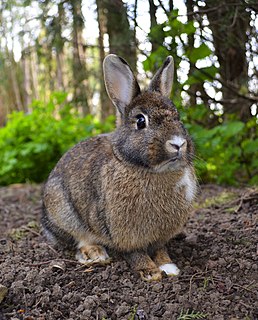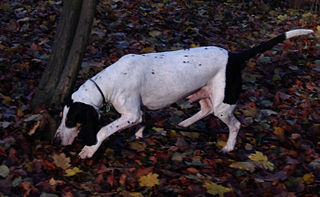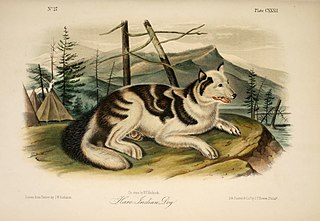
Rabbits are small mammals in the family Leporidae of the order Lagomorpha. Oryctolagus cuniculus includes the European rabbit species and its descendants, the world's 305 breeds of domestic rabbit. Sylvilagus includes 13 wild rabbit species, among them the seven types of cottontail. The European rabbit, which has been introduced on every continent except Antarctica, is familiar throughout the world as a wild prey animal and as a domesticated form of livestock and pet. With its widespread effect on ecologies and cultures, the rabbit is, in many areas of the world, a part of daily life—as food, clothing, a companion, and as a source of artistic inspiration.

Hares and jackrabbits are leporids belonging to the genus Lepus. Hares are classified in the same family as rabbits. They are similar in size and form to rabbits and have similar herbivorous diets, but generally have longer ears and live solitarily or in pairs. Also unlike rabbits, their young are able to fend for themselves shortly after birth rather than emerging blind and helpless. Most are fast runners. Hare species are native to Africa, Eurasia and North America.

The Hare's Ear is a traditional artificial fly imitating an aquatic insect larva (nymph) used in fly fishing.

Bupleurum is a large genus of annual or perennial herbs or woody shrubs, with about 190 species, belonging to the family Apiaceae. The full size of its species may vary between a few cm to up to 3 m high. Their compound umbels of small flowers are adorned with bracteoles that are sometimes large and may play a role in attracting pollinators. Rare among the Apiaceae are the simple leaves, bracts, and bracteoles. The genus is almost exclusively native in the Old World Northern Hemisphere, with one species native to North America and one species native to southern Africa.

Horseshoe Bend, Shirehampton is an 11 acre biological Site of Special Scientific Interest in Bristol, England, on the north bank of a lower, tidal stretch of the River Avon, 1.9 miles (3 kilometres) downstream from the Avon Gorge, and just east of the village of Shirehampton. It was notified as an SSSI in 1999.

The Kritikos Lagonikos is a hunting breed of dog from the island of Crete, in Greece. It is considered to be one of the oldest hunting breeds in Europe, with a history that goes back to 3,500 years ago.

The Ariegeois is a breed of dog from the département of Ariège in the Midi-Pyrenées region of southern France. It is a medium-sized pack-hunting scenthound deriving from crossing of Grand Bleu de Gascogne and Grand Gascon-Saintongeois hounds with local Briquet dogs. It is used both as a courser and for driving game to waiting guns. While most successful with hares, it is also used for hunting deer and boar. It is distinguished by its friendly nature with other hounds and affection for human companions.

The North Country Beagle, Northern Hound or Northern Beagle was a breed of dog that existed in Britain probably until early in the 19th century. The exact date of its extinction is not known; it is likely that it was gradually interbred with other breeds, particularly the modern Beagle, until the genuine North Country Beagle bloodline ceased to exist.

The Alaskan hare, also known as the tundra hare, is a species of mammal in the family Leporidae. They do not dig burrows and are found in the open tundra of western Alaska and the Alaska Peninsula in the United States. They are solitary for most of the year except during mating season, when they produce a single litter of up to eight young. Predators include birds of prey and polar bears, as well as humans for sport hunting.
NVC community CG1 is one of the calcicolous grassland communities in the British National Vegetation Classification system. It is one of three short-sward communities associated with heavy grazing, within the lowland calcicolous grassland group, and is regarded as the south-west coastal counterpart of "typical" chalk grassland.

The Hare Indian dog is an extinct domesticated canine; possibly a breed of domestic dog, coydog, or domesticated coyote; formerly found and originally bred in northern Canada by the Hare Indians for coursing. It had the speed and some characteristics of the coyote, but the domesticated temperament and other characteristics of a domestic dog. It gradually lost its usefulness as aboriginal hunting methods declined, and became extinct or lost its separate identity through interbreeding with dogs in the 19th century, though some claim the breed still exists in modified form.

Bupleurum falcatum, also known as sickle-leaved hare's-ear, Chinese thoroughwax, sickle hare's ear and sickle-leaf hare's ear, is a species of flowering plant in the family Apiaceae.

The Ziegenberg is a low ridge between the villages of Benzingerode and Heimburg on the northern edge of the Harz Mountains in central Germany. The ridge is a designated nature reserve. The reserve has an area of 88.4 hectares and has a variety of habitats including mesophytic grassland (Halbtrockenrasen), bushes, pine woods and wet meadows. Its highest points are the eponymous Ziegenberg and the Struvenberg

Vápenice is a natural monument south-east of the village of Slatinky in the Prostějov District of the Czech Republic. It is a part of the nature park Velký Kosíř. The area is administered by the Nature Conservation Agency of the Czech Republic.
Bupleurum sintenisii, the dwarf hare's ear, is an annual herb, 1–5 cm high, hairless and glaucous. Leaves alternate, simple, entire, linear, 10-20 x 0.5-1.5 mm. The inconspicuous flowers are yellowish to brownish and crowded in umbels. Flowers from May to July. The fruit is a dry schizocarp, covered by hooded bristles.

Hamford Water is a 2,185.8-hectare (5,401-acre) biological Site of Special Scientific Interest between Walton-on-the-Naze and Harwich in Essex. The site is a tidal inlet which has marsh grasslands, creeks, mud and sand flats, salt marshes, islands and beaches. It is described by Natural England as "of international importance for breeding little terns and wintering dark-bellied brent geese, wildfowl and waders, and of national importance for many other bird species." Rare plants include hog's fennel and slender hare's-ear. The main invertebrates are worms and thin-shelled molluscs. The largest island, Horsey Island, can be reached on foot at low tide across The Wade from Kirby-le-Soken.

Bupleurum fruticosum or shrubby hare's-ear is a species of flowering plant in the family Apiaceae. It is endemic to the Mediterranean region. It lives in sunny hills, walls and rocky places.

Medway Estuary and Marshes is a 4,748.8-hectare (11,735-acre) biological Site of Special Scientific Interest which stretches along the banks of the River Medway between Gillingham and Sheerness in Kent. It is a Nature Conservation Review site, Grade I, a Ramsar internationally important wetland site, and a Special Protection Area under the European Union Directive on the Conservation of Wild Birds.

Bupleurum baldense, the small hare's ear, is a plant species of the genus Bupleurum.

Hook with Warsash is a 251.6-hectare (622-acre) Local Nature Reserve west of Fareham in Hampshire. It is owned by Hampshire County Council and managed by Hampshire Countryside Service. It is part of Solent and Southampton Water Ramsar site and Special Protection Area, of Solent Maritime Special Area of Conservation, and of Lee-on-The Solent to Itchen Estuary Site of Special Scientific Interest.


















